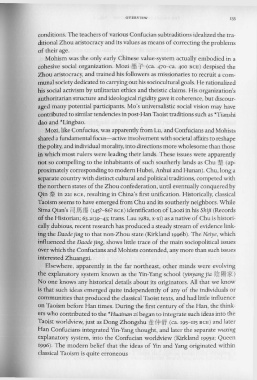Page 173 - The Encyclopedia of Taoism v1_A-L
P. 173
OVERVIEW 133
conditions. The teachers of various Confucian subtraditions idealized the tra-
ditional Zhou aristocracy and its values as means of correcting the problems
of their age.
Mohism was the only early Chinese value-system actually embodied in a
cohesive social organization. Mozi ~r (ca. 470-ca. 400 BeE) despised the
Zhou aristocracy, and trained his followers as missionaries to recruit a com-
munal society dedicated to carrying out his sociocultural goals. He rationalized
his social activism by utilitarian ethics and theistic claims. His organization's
authoritarian structure and ideological rigidity gave it coherence, but discour-
aged many potential participants. Mo's universalistic social vision may have
contributed to similar tendencies in post-Han Taoist traditions such as *Tianshi
dao and *Lingbao.
Mozi, like Confucius, was apparently from Lu, and Confucians and Mohists
shared a fundamental focus-active involvement with societal affairs to reshape
the polity, and individual morality, into directions more wholesome than those
in which most rulers were leading their lands. These issues were apparently
not so compelling to the inhabitants of such southerly lands as Chu ~ (ap-
proximately corresponding to modern Hubei, Anhui and Hunan). Chu, long a
separate country with distinct cultural and political traditions, competed with
the northern states of the Zhou confederation, until eventually conquered by
Qin * in 221 BeE, resulting in China's first unification. Historically, classical
Taoism seems to have emerged from Chu and its southerly neighbors. While
Sima Qian's PJ ~~ (145?-86? BeE) identification of Laozi in his Shiji (Records
of the Historian; 63.2139- 43; trans. Lau 1982, x-xi) as a native of Chu is histori-
cally dubious, recent research has produced a steady stream of evidence link-
ing the Daode jing to that non-Zhou state (Kirkland 1996b). The Neiye, which
influenced the Daode jing, shows little trace of the main sociopolitical issues
over which the Confucians and Morusts contended, any more than such issues
interested Zhuangzi.
Elsewhere, apparently in the far northeast, other minds were evolving
the explanatory system known as the Yin-Yang school (yinyang jia Il1i ~ *)
No one knows any historical details about its originators. All that we know
is that such ideas emerged quite independently of any of the individuals or
communities that produced the classical Taoist texts, and had little influence
on Taoism before Han times. During the first century of the Han, the think-
ers who contributed to the *Huainan zi began to integrate such ideas into the
Taoist worldview, just as Dong Zhongshu liifrpff (ca. 195-II5 BeE) and later
Han Confucians integrated Yin-Yang thought, and later the separate wuxing
explanatory system, into the Confucian worldview (Kirkland 1995a; Queen
1996). The modern belief that the ideas of Yin and Yang originated within
classical Taoism is quite erroneous

